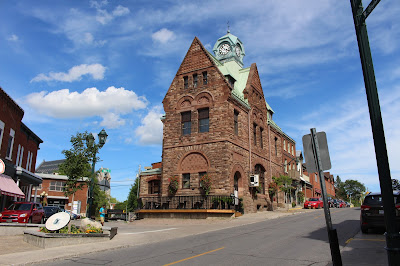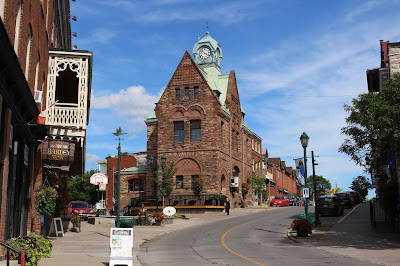In Almonte, Ontario, north of Mill Street between the junctions of Brae Street and Littel Bridge Street, sits the statue of Dr. James Naismith, looking ready to give a lesson in how to play basketball.
 |
Dr. James Naismith, Inventor of Basketball
Born: November 6 1861, Ramsay Township, Ontario
Died: November 28 1939, Lawrence, Kansas
Statue Commissioned by the Dr. James Naismith Basketball Foundation
Directors:
Allen Rae, James Lowry, John Gosset, Gunnar Laatunen,
Kathy Stewart, Bonnie McBain, Kristen Ray, Kevin Lee
Dedicated July 23 2011
Sculptor Elden Tefft -- Lawrence, Kansas |
James Naismith
James Naismith was born on November 6th, 1861, the son of John Naismith and Margaret Young. His birthplace was on the family farm in Ramsay Township, approximately 3 kilometers north of Almonte, Ontario. At the age of nine his parents died of typhoid fever, leaving James, sister Annie and brother Robert to be raised by their uncle, P. J. Young.
He attended grade school at Bennie's Corners, north of Almonte, and high school in Almonte. In 1883 he enrolled at McGill University in Montreal where he earned a BA in Physical Education and was an avid particiapnt in football, rugby, lacrosse and ground gymnastics. In 1887 he entered the Presbyterian College of Theology in Montreal, where he obtained a diploma in 1890. Having completed his studies and McGill, Naismith joined the staff of the YMCA Training School in Springfield, Massachusetts.

During his time in Springfield, Naismith was given the task of developing an indoor game which could be played during the winter months, that was fair to all players and was free of rough play. While contemplating this asssignment Naismith drew upon a game he had played as a youth, called "Duck on a Rock". The objective of this new game involved a ball being tossed into peach baskets, of which two had been nailed ten feet off the floor, located at each end of the gymnasium. Naismith found the most accurate technique to toss the ball into the basket was to arc the throw, a method he remembered from his days playing "Duck on a Rock".
Naismith then drew up a set of 13 rules with each team consisting of 9 players. On December 21st, 1891 Naismith's new game of "Basketball" was introduced to one of his classes at the Springfield YMCA gymnasium. The first official team consisted of 5 Americans and 4 Canadians. The game of basketball successfully caught on internationally and is now one of the most popular team sports in the world.
In 1895 Naismith moved to Denver, Colorado where he became the Director of Physical Education at the YMCA. While in Denver he attended Gross Medical School and graduated in 1898, with a degree of Doctor of Medicine. In 1898 he moved to Lawrence, Kansas where he became the Director of the Gymnasium, Campus Chaplain and Basketball Coach and the University of Kansas until his retirement in 1937.
Naismith was in attendance when basketball was first played as an official Olympic Sport at the 1936 Olympic Games in Berlin, Germany.
Dr. James Naismith passed away on November 28th, 1939 in Lawrence, Kansas.
James Naismith
James Naismith est né le 6 novembre 1861, le fils de John Naismith et Margaret Young. Son lieu de naissance a été sur la ferme familiale dans la municipalité de Ramsay, inviron 3 kilomètres au nord d'Almonte, en Ontario. À l'âge de neuf ans ses parents sont morts de la fièvre typhoïde, laissant James, sa soeur Annie et son frère Robert à être élevés par leur oncle, PJ Young.
Il a fréquenté l'école primaire à Bennie's Corners, au nord d'Almonte, et l'école secondaire à Almonte. En 1883, il s'est inscrit à l'Université McGill à Montréal où il a obtenu un baccalauréat en éducation physique et il était un paricipant passionné au football, au rugby, à la crosse et à la gymnastique au sol. En 1887, il a entré au collège prebytérien de théologie à Montréal, où il a obtenu un diplôme en 1890. Après avoir terminé ses études à l'Université McGill, Naismith a rejoint le personnel de l'École de formation du YMCA de Springfield, dans l'état du Massachusetts.

Lors de son séjour à Springfield, Naismith a été confié la tâche de développer un jeu intérieur qui pourrait être joué pendant les mois d'hiver, qui était équitable pour tous les joueurs et était libre de jeu rugueux. En contemplant cette mission, Naismith s'est appuyé sur un jeu qu'il avait joué dans sa jeunesse, appelé « Canard sur un rocher ». L'objectif de ce nouveau jeu impliquait une balle qui est lancée dans des paniers de pêches, dont deux avaient été cloués dix pieds du sol, situés à chaque extrémité du gymnase. Naismith a constaté que la technique la plus précise pour lancer la balle dans le panier était de le lancer à l'arc, une méthode qu'il se souvenait de ses journées à jouer au « Canard sur un rocher ».
Naismith a ensquite élaboré un ensemble de 13 règles avech chaque équipe composée 9 joueurs. Le 21 décembre 1891, le nouveau jeu du "Basketball" de Naismith a été introduit à l'un de ses cours au gymnase du YMCA de Springfield. La première équipe officielle était composée de 5 Américains et 4 Canadiens. Le jeu du basketball s'est présenté sur la scène internationale avec succès et est maintenant l'un des sprots d'équipe les plus populaires au monde.
En 1895, Naismith a déménagé à Denver, au Colorado, où il est devenu le directeur de l'éducation physique au YMCA, Lors de son séjour à Denver, il a suivi des cours au Gross Medical School et a gradué en 1898, avec un diplôme de docteur en médecine. En 1898 il a déménagé à Lawrence, au Kansas, où il est devenu le directeur du Gymnase du campus Chaplain et entraîneur de basketball à Université du Kansas jusqu'à sa retraite en 1937.
Naismith était présent lorsque le basketball a été joué pour la première fois en tant que sport olympique officiel aux Jeux Olympiques de 1936 à Berlin, en Allemagne.
Dr. James Naismith est décédé le 28 novembre 1939 à Lawrence, au Kansas.



















































